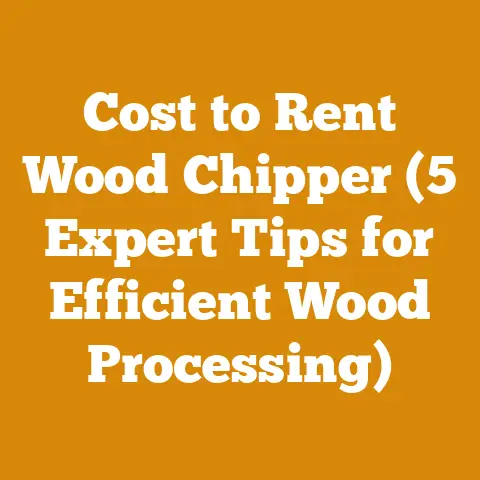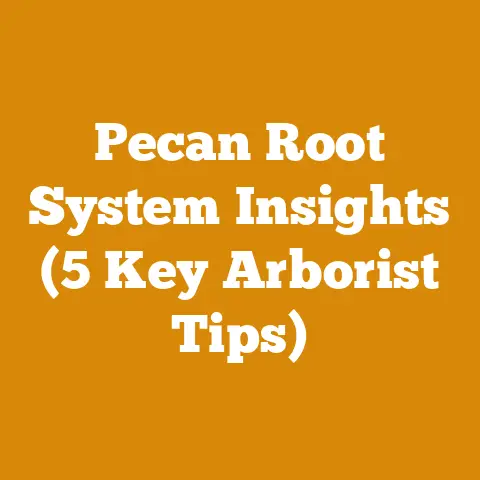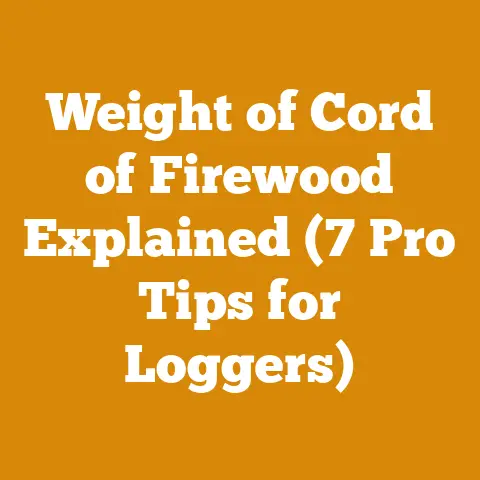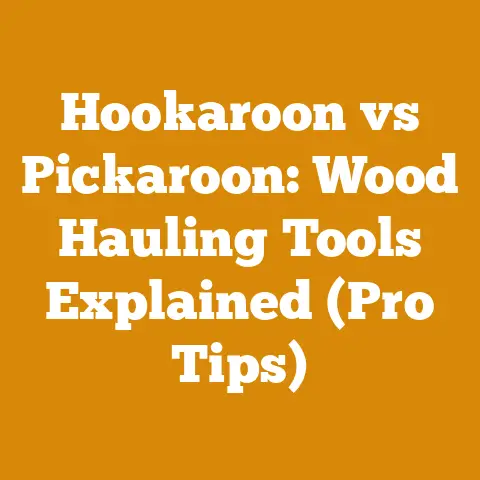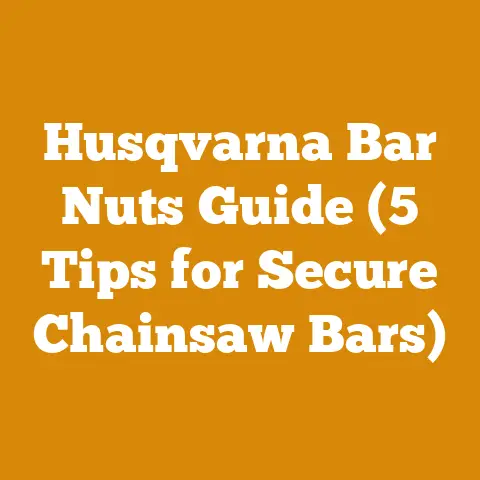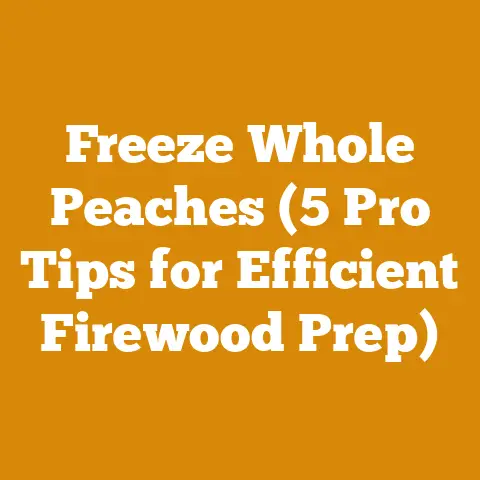Emerald Ash Borer Treatment DIY (5 Proven Woodcare Hacks)
Are you tired of watching your beautiful ash trees succumb to the devastating Emerald Ash Borer (EAB) and wondering if a DIY approach is even feasible?
I get it.
I’ve seen firsthand the heartbreak of losing majestic ash trees, and the frustration of seemingly endless treatment options.
This article isn’t just a list of woodcare hacks; it’s a deep dive into the real costs, the practicalities, and the effectiveness of tackling EAB treatment yourself.
We’ll explore five proven methods, dissect the expenses involved, and arm you with the knowledge to make an informed decision about protecting your trees and your wallet.
Emerald Ash Borer Treatment: DIY – Can You Really Save Your Ash Trees?
The Emerald Ash Borer (EAB) has become a nemesis to ash trees across North America and beyond.
This invasive beetle, originally from Asia, has decimated ash populations, leaving behind a trail of dead and dying trees.
The question many homeowners face is: can I effectively treat my ash trees myself, and more importantly, is it worth the cost?
Understanding the Emerald Ash Borer Threat
Before we jump into DIY treatments, it’s crucial to understand the enemy.
The EAB larva feeds on the inner bark of ash trees, disrupting the tree’s ability to transport water and nutrients.
This leads to canopy dieback, and eventually, the death of the tree.
Signs of EAB infestation include:
- D-shaped exit holes: These are small, distinctive holes left by adult beetles emerging from the tree.
- Canopy dieback: The upper branches of the tree begin to die, leading to sparse foliage.
- Bark splitting: Vertical splits may appear in the bark, often revealing S-shaped galleries created by the larvae.
- Increased woodpecker activity: Woodpeckers often feed on EAB larvae, leading to noticeable activity on infested trees.
If you suspect your ash tree is infested, it’s important to confirm the presence of EAB before initiating any treatment.
Contacting your local forestry department or a certified arborist is a good first step.
The Economic Impact of EAB
The economic impact of EAB is staggering.
Billions of dollars have been spent on tree removal, replanting, and treatment.
For homeowners, the cost of inaction can be significant, including:
- Loss of property value: A healthy, mature tree can significantly increase property value.
Losing an ash tree can decrease your home’s worth. - Removal costs: Removing a large, dead ash tree can be expensive, often costing hundreds or even thousands of dollars.
- Potential hazard: Dead or dying trees pose a safety hazard, especially during storms.
Therefore, investing in EAB treatment can be a smart financial decision, especially if you value your trees and your property.
DIY EAB Treatment Options: A Cost-Benefit Analysis
Now, let’s delve into the five proven DIY EAB treatment options and break down their costs, effectiveness, and potential drawbacks.
1. Systemic Insecticides: Soil Drenching
What it is: Soil drenching involves applying a systemic insecticide to the base of the tree.
The insecticide is then absorbed by the roots and transported throughout the tree, killing EAB larvae as they feed.
Active Ingredient: Imidacloprid is the most common active ingredient used in soil drench insecticides.
Application: The insecticide is mixed with water and poured around the base of the tree, following the manufacturer’s instructions.
Effectiveness: Soil drenching can be effective, but its success depends on several factors, including the size of the tree, the severity of the infestation, and the soil conditions.
It’s generally more effective on smaller trees with less severe infestations.
Cost Breakdown:
- Insecticide: A 32-ounce bottle of imidacloprid concentrate typically costs between $30 and $50, depending on the brand and concentration.
I usually buy mine from a local agricultural supply store, as they often have better prices than big box retailers. - Application tools: A watering can or garden sprayer is needed for application.
Most homeowners already have these tools, but if you need to purchase one, expect to spend around $10 to $20. - Labor: This is where the DIY approach shines.
The labor cost is essentially your time.
Applying a soil drench typically takes about 30 minutes to an hour, depending on the size of the tree.
Data and Statistics:
- A study by Michigan State University found that soil drenching with imidacloprid provided good control of EAB in small to medium-sized trees.
- The cost of soil drenching is significantly lower than professional treatments, which can range from $100 to $500 per tree, depending on the size and location.
Pros:
- Relatively inexpensive
- Easy to apply
- Can be effective on smaller trees
Cons:
- May not be effective on large trees or severe infestations
- Requires annual application
- Potential for environmental impact if not applied correctly
My Experience: I’ve used soil drenching on several smaller ash trees on my property.
I found it to be relatively easy to apply, and I did see a reduction in EAB activity.
However, I noticed that the effectiveness decreased on larger trees, and I eventually had to switch to a different treatment method for those.
2. Systemic Insecticides: Trunk Injection
What it is: Trunk injection involves injecting insecticide directly into the trunk of the tree.
This allows for faster and more efficient distribution of the insecticide throughout the tree.
Active Ingredient: Emamectin benzoate is the most common active ingredient used in trunk injection insecticides.
Application: The insecticide is injected into small holes drilled into the trunk of the tree, using a specialized injection device.
Effectiveness: Trunk injection is generally considered to be more effective than soil drenching, especially on larger trees and severe infestations.
It provides longer-lasting protection, often lasting for two years.
Cost Breakdown:
- Insecticide: A single dose of emamectin benzoate insecticide for a medium-sized tree (12-inch diameter) typically costs between $50 and $80.
Larger trees will require a higher dose, increasing the cost. - Injection device: This is the most significant upfront cost.
Manual injection devices can range from $100 to $300, while more sophisticated power-operated devices can cost upwards of $500. - Drill: You’ll need a drill to create the injection holes.
Most homeowners already have a drill, but if you need to purchase one, expect to spend around $50 to $100. - Labor: Trunk injection requires more skill and effort than soil drenching.
It can take several hours to treat a large tree.
Data and Statistics:
- Studies have shown that trunk injection with emamectin benzoate can provide up to two years of protection against EAB.
- The cost of trunk injection is higher than soil drenching, but it can be more cost-effective in the long run due to its longer-lasting protection.
Pros:
- Highly effective, even on large trees and severe infestations
- Long-lasting protection (up to two years)
- Minimal environmental impact
Cons:
- Higher upfront cost for injection device
- Requires more skill and effort to apply
- Potential for tree damage if not applied correctly
My Experience: I invested in a trunk injection device after soil drenching proved insufficient for my larger ash trees.
While the initial cost was higher, I was impressed with the results.
The trees showed significant improvement, and I didn’t have to reapply the treatment every year.
However, it’s crucial to follow the instructions carefully and avoid over-injecting the tree.
3. Horticultural Oil
What it is: Horticultural oil is a highly refined mineral oil that is sprayed onto the tree to suffocate EAB larvae and eggs.
Application: The oil is diluted with water and sprayed onto the trunk and branches of the tree, ensuring complete coverage.
Effectiveness: Horticultural oil is most effective when applied during the dormant season, before the EAB larvae become active.
It can help to reduce EAB populations, but it is not a standalone treatment and should be used in conjunction with other methods.
Cost Breakdown:
- Horticultural oil: A gallon of horticultural oil concentrate typically costs between $20 and $40.
- Sprayer: A garden sprayer is needed for application.
A good quality sprayer can cost around $30 to $50. - Labor: Applying horticultural oil can be time-consuming, especially on large trees.
It’s important to ensure complete coverage, which may require multiple applications.
Data and Statistics:
- Horticultural oil is an environmentally friendly option for EAB control, as it is non-toxic to humans and animals.
- Studies have shown that horticultural oil can be effective in reducing EAB populations, but it is not as effective as systemic insecticides.
Pros:
- Environmentally friendly
- Relatively inexpensive
- Can be used in conjunction with other treatments
Cons:
- Less effective than systemic insecticides
- Requires multiple applications
- Can be time-consuming to apply
My Experience: I’ve used horticultural oil as a preventative measure on my ash trees, particularly during the dormant season.
It’s a good option for those concerned about the environmental impact of insecticides.
However, I wouldn’t rely on it as the sole treatment for an active EAB infestation.
4. Insecticidal Soap
What it is: Insecticidal soap is a mixture of potassium salts of fatty acids that disrupt the cell membranes of insects, leading to their death.
Application: The soap is diluted with water and sprayed directly onto the EAB larvae and eggs.
Effectiveness: Insecticidal soap is most effective when applied directly to the EAB larvae.
This can be difficult to achieve, as the larvae are typically located beneath the bark of the tree.
Therefore, insecticidal soap is generally not considered to be an effective treatment for EAB.
Cost Breakdown:
- Insecticidal soap: A 32-ounce bottle of insecticidal soap concentrate typically costs between $10 and $20.
- Sprayer: A garden sprayer is needed for application.
- Labor: Applying insecticidal soap can be time-consuming, as it requires thorough coverage of the tree.
Data and Statistics:
- Insecticidal soap is a relatively safe and environmentally friendly option for insect control.
- However, it is not very effective against EAB, as the larvae are protected beneath the bark of the tree.
Pros:
- Safe and environmentally friendly
- Inexpensive
Cons:
- Not very effective against EAB
- Requires direct contact with the larvae
- Can be time-consuming to apply
My Experience: I’ve experimented with insecticidal soap on my ash trees, but I haven’t seen significant results.
It might be useful for controlling other pests on the tree, but it’s not a reliable solution for EAB.
5. Tree Bands and Traps
What it is: Tree bands and traps are designed to capture adult EAB beetles as they emerge from the tree.
Application: Tree bands are wrapped around the trunk of the tree, while traps are hung from the branches.
Effectiveness: Tree bands and traps can help to reduce EAB populations, but they are not a standalone treatment and should be used in conjunction with other methods.
Cost Breakdown:
- Tree bands: A tree band typically costs between $5 and $10.
- Traps: A trap typically costs between $10 and $20.
- Labor: Installing tree bands and traps is relatively easy and takes only a few minutes per tree.
Data and Statistics:
- Tree bands and traps can be effective in monitoring EAB populations and detecting new infestations.
- However, they are not as effective as systemic insecticides in controlling EAB.
Pros:
- Relatively inexpensive
- Easy to install
- Can be used to monitor EAB populations
Cons:
- Not a standalone treatment
- May not be very effective in controlling EAB
- Can be unsightly
My Experience: I’ve used tree bands and traps as a supplementary measure on my property.
They’re a good way to monitor EAB activity and get a sense of the beetle population in your area.
However, I wouldn’t rely on them as the primary means of protecting my ash trees.
Deep Dive: Cost Factors and Budgeting for EAB Treatment
Now that we’ve covered the various treatment options, let’s delve deeper into the cost factors and how to budget effectively for EAB treatment.
Wood Species and Quality
The species of ash tree and its overall health can significantly impact the cost of treatment.
A healthy, vigorous tree is more likely to respond well to treatment than a stressed or declining tree.
Furthermore, some ash species are more susceptible to EAB than others.
For instance, green ash tends to be more vulnerable than white ash.
Location Accessibility
The accessibility of the tree also plays a role in the cost of treatment.
If the tree is located in a difficult-to-reach area, such as on a steep slope or behind a building, it may be more challenging and expensive to treat.
This is particularly relevant if you’re considering hiring a professional arborist.
Seasonality
The timing of treatment is crucial for its effectiveness.
Systemic insecticides are most effective when applied during the growing season, when the tree is actively transporting water and nutrients.
Horticultural oil is best applied during the dormant season.
Failing to time the treatment correctly can reduce its effectiveness and potentially waste your money.
Timber Purchase or Harvesting Costs (If Applicable)
If you’re treating trees in a forested area, you may need to consider the cost of timber purchase or harvesting.
This can include the cost of acquiring the timber rights, as well as the cost of logging and transporting the trees.
However, for most homeowners, this is not a relevant cost factor.
Tool Maintenance
Maintaining your tools is essential for effective EAB treatment.
This includes cleaning and sharpening your pruning tools, calibrating your sprayer, and ensuring that your injection device is in good working order.
Neglecting tool maintenance can lead to ineffective treatment and potentially damage your trees.
Labor Wages (If Hiring Help)
If you’re not comfortable performing the EAB treatment yourself, you may need to hire a professional arborist.
Labor costs can vary depending on the arborist’s experience, location, and the complexity of the job.
Be sure to get multiple quotes and compare prices before hiring someone.
Permits (If Applicable)
In some areas, you may need to obtain a permit before treating your ash trees.
Check with your local forestry department or municipality to determine if any permits are required.
Current Industry Benchmarks and Statistical Data
- The average cost of removing a dead ash tree ranges from $500 to $2,000, depending on the size and location of the tree.
- The average cost of professional EAB treatment ranges from $100 to $500 per tree per year, depending on the size of the tree and the type of treatment.
- The Emerald Ash Borer has killed tens of millions of ash trees in North America, causing billions of dollars in economic damage.
Practical Tips for Cost Optimization and Budget Management
- Prioritize your trees: Focus on treating the most valuable and healthy ash trees first.
- Start early: Begin treatment as soon as you detect signs of EAB infestation.
- Choose the right treatment method: Select the treatment method that is most appropriate for the size and severity of the infestation.
- Shop around for supplies: Compare prices from different retailers to find the best deals on insecticides and other supplies.
- Consider DIY options: If you’re comfortable performing the treatment yourself, you can save a significant amount of money.
- Maintain your trees: Proper tree care, including watering, fertilizing, and pruning, can help to improve the tree’s overall health and resistance to EAB.
- Monitor your trees: Regularly inspect your ash trees for signs of EAB infestation.
Technical Explanations and Calculations
Calculating Insecticide Dosage
The amount of insecticide needed for EAB treatment depends on the size of the tree.
The general rule of thumb is to use 1 ounce of insecticide per inch of trunk diameter.
To calculate the trunk diameter, measure the circumference of the tree at breast height (4.5 feet above the ground) and divide by pi (3.14).
For example, if a tree has a circumference of 37.68 inches, its diameter is 37.68 / 3.14 = 12 inches.
Therefore, you would need 12 ounces of insecticide to treat this tree.
Estimating Drying Time for Firewood
If you’re cutting down infested ash trees for firewood, it’s important to dry the wood properly to prevent fungal growth and ensure efficient burning.
The drying time depends on several factors, including the species of wood, the size of the pieces, and the climate.
As a general rule, firewood should be dried for at least six months before burning.
To speed up the drying process, split the wood into smaller pieces and stack it in a sunny, well-ventilated area.
Formulas and Calculations
- Trunk Diameter = Circumference / π
- Insecticide Dosage = Trunk Diameter (inches) x 1 ounce
- Firewood Drying Time = Species Factor x Piece Size Factor x Climate Factor
Cost Comparison Tables for Different Logging Tools
Note: These are approximate prices and may vary depending on the brand, model, and location.
Visual Elements
Chart: A bar chart comparing the cost of different EAB treatment options (soil drenching, trunk injection, horticultural oil, etc.).
Table: A table summarizing the pros and cons of each treatment option.
Calculator: An online calculator that allows users to estimate the cost of EAB treatment based on the size and number of their ash trees.
Actionable Takeaways and Next Steps
- Assess your ash trees: Determine the health and value of your ash trees.
- Identify the signs of EAB infestation: Look for D-shaped exit holes, canopy dieback, and bark splitting.
- Choose the right treatment method: Select the treatment method that is most appropriate for your situation.
- Create a budget: Estimate the cost of treatment and create a budget.
- Gather your supplies: Purchase the necessary insecticides, tools, and equipment.
- Apply the treatment: Follow the manufacturer’s instructions carefully.
- Monitor your trees: Regularly inspect your ash trees for signs of EAB infestation.
Idioms and Expressions
- “An ounce of prevention is worth a pound of cure.”
- “Don’t put all your eggs in one basket.”
- “A penny saved is a penny earned.”
- “Look before you leap.”
- “Where there’s a will, there’s a way.”
Challenges Faced by Small-Scale Loggers and Firewood Suppliers
Small-scale loggers and firewood suppliers face a number of challenges, including:
- Fluctuating timber prices: Timber prices can fluctuate significantly, making it difficult to plan and budget for wood harvesting.
- High equipment costs: Logging equipment can be expensive to purchase and maintain.
- Competition from larger companies: Small-scale loggers often face competition from larger companies that have more resources and can offer lower prices.
- Environmental regulations: Environmental regulations can add to the cost of logging and firewood preparation.
- Labor shortages: It can be difficult to find and retain qualified workers for logging and firewood preparation.
Compelling Phrases
- “Protect your valuable ash trees from the devastating Emerald Ash Borer.”
- “Take control of your EAB treatment and save money.”
- “Learn the secrets to effective and affordable EAB control.”
- “Don’t let the Emerald Ash Borer destroy your beautiful ash trees.”
- “Invest in your trees and protect your property value.”
Technical Terms
- Systemic insecticide: An insecticide that is absorbed by the plant and transported throughout its tissues.
- Horticultural oil: A highly refined mineral oil that is used to control insects and diseases on plants.
- Insecticidal soap: A mixture of potassium salts of fatty acids that is used to control insects on plants.
- Dormant season: The period of time when plants are not actively growing.
- Trunk diameter: The width of the tree trunk.
- Circumference: The distance around the tree trunk.
- Board foot: A unit of measurement for lumber.
- Cord: A unit of measurement for firewood.
Conclusion
Protecting your ash trees from the Emerald Ash Borer is a worthwhile investment, both economically and aesthetically.
While professional treatments can be effective, they can also be expensive.
By understanding the various DIY treatment options, their costs, and their effectiveness, you can make an informed decision about how to protect your trees and your wallet.
Remember to prioritize your trees, start early, choose the right treatment method, and maintain your trees properly.
With a little effort and knowledge, you can successfully combat the Emerald Ash Borer and preserve your beautiful ash trees for years to come.

